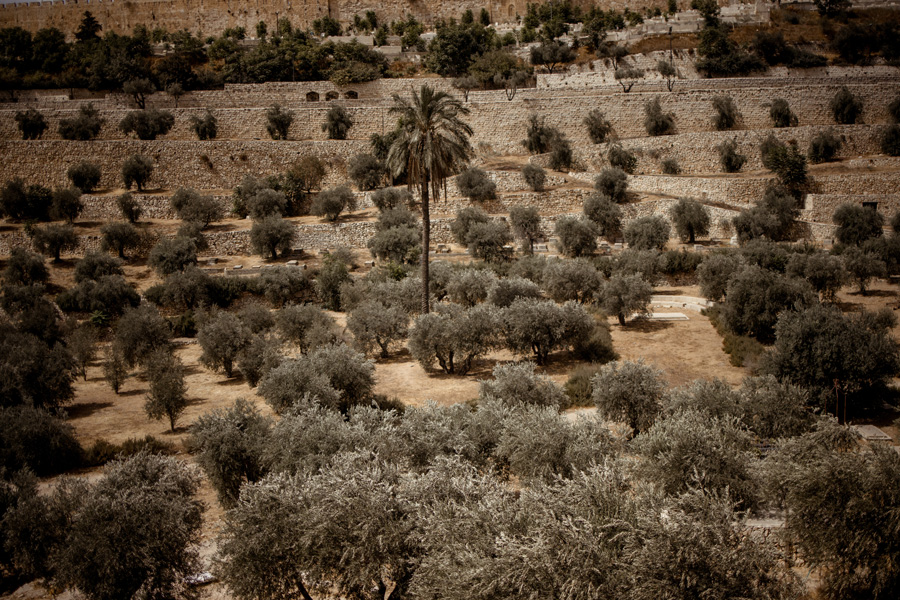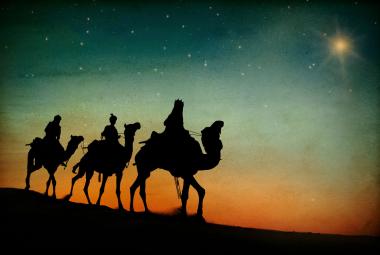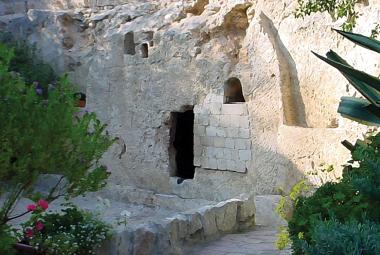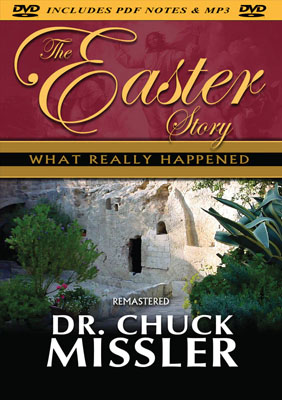Jesus had arrived at the home of Lazarus, Mary, and Martha in Bethany, on Friday of the week before He died. He returned to Bethany every evening, during the course of the next week. Bethany was a small village just on the other side of the Mount of Olives. This meant Jesus and his disciples went back and forth across the Mount of Olives every day on their way to and from Jerusalem.
Matthew 24 and Mark 13 both describe an evening when Jesus and the disciples have gone to sit up on the Mount of Olives and gaze down at Jerusalem at the Temple Mount. They’ve just left the Temple, where Jesus told them that every stone of the beautiful buildings would be thrown down. This leads Peter, Andrew, James and John to quietly ask Him in Mark 13:4, “Tell us, when shall these things be?” Jesus answers them by describing the end times and the coming of the Antichrist. These descriptions have been called the Olivet Discourse, because Jesus gave it on the Mount of Olives.
Luke 21 is sometimes confused with the Olivet Discourse, but it’s a completely different presentation to a different audience with a different emphasis. Luke 21 describes the siege of Jerusalem by the Romans, which would take place in a few decades. In AD 69-70 the Romans conquered Jerusalem and destroyed the Temple, killing multitudes of Jews. Jesus warns that Jerusalem would be taken over until the end of the “times of the Gentiles”
And they shall fall by the edge of the sword, and shall be led away captive into all nations: and Jerusalem shall be trodden down of the Gentiles, until the times of the Gentiles be fulfilled.
Luke 21:24
There is hope at the end, Jesus says, because after the times of the Gentiles, He would return as the Son of Man in great glory. This is a different emphasis, than what Jesus tells James, John, Peter and Andrew alone on the Mount of Olives. So, we need to be careful not to confuse Luke 21 with the Olivet Discourse.

Sitting on the Mount of Olives, Jesus explains to His closest disciples that there would be a large number of what I call “non-signs.” There would be wars and rumors of wars and earthquakes and diseases, but these wouldn’t be the signs of the end. There would be persecution of the saints as well, and they would be killed. False prophets would rise up and deceive many people. These things would all happen, but they were not the signs of the end times. The end would come, Jesus said, after the gospel was preached to the entire world. He then warns us all about the Abomination of Desolation, which is associated in 2 Thessalonians 2:3-4 with the Man of Sin. In our culture, we commonly refer to this man as the Antichrist. Jesus says that the greatest tribulation in history would begin with the Abomination of Desolation in the Holy Place of the Temple, as described by the prophet Daniel.1
Again, Jesus gives hope because, after the tribulation of those days, He says He will return in the clouds with great glory. However, He also warns us not to be deceived by the many false Christs who will arise in the meantime. When He comes, it will be clear and obvious, like a sky-wide lightning flash.
It’s surprising to realize how many of the stories Jesus tells, the lessons He teaches, the warnings He gives, that were all offered that final week. We believe that Matthew, the former tax collector, would have had shorthand skills, and it seems he was writing the Lord’s words down verbatim during that time. He includes many long discourses by Jesus. It is John, however, who tells us of the things Jesus said during the Last Supper. John 13-17 were all personal sayings Jesus gave to His disciples that night, just hours before Judas betrayed Him. They were words close to John’s heart — words that had remained with him his whole life. As Jesus told the disciples in John 14:26:
But the Comforter, which is the Holy Ghost, whom the Father will send in my name, he shall teach you all things, and bring all things to your remembrance, whatsoever I have said unto you.
The next few days went by fairly quickly. The fig tree was cursed. Jesus upbraided the scribes and Pharisees, calling them hypocrites and whitewashed sepulchers. Jesus gave His parables about the ten virgins and the sheep and the goats. Then, on Tuesday Jesus instructed His disciples about where to eat the Passover meal, and they all gathered in the upper room for a final supper together as the Wednesday Passover began.
The Final Night
This brings us to the events of the Last Supper. The night before Christ’s crucifixion, the disciples gathered with Jesus in the upper room to eat their final Passover meal together. We call it the Last Supper, but it is more properly called the Last Seder since it was specifically the Passover meal. Matthew 26:17-35 gives us the backbone of that night, and we also pick up some insights in Mark 14 and Luke 22. John’s Gospel is unique, having been written many years after the others. He doesn’t worry about covering all the same ground as Matthew Mark and Luke. He does include the most important aspects of Jesus’ ministry and life, but He focuses on filling in gaps that the others leave out. This includes the Lord’s discourses that evening before Jesus went out to grieve and pray in the Garden of Gethsemane. John alone details the Lord’s words after supper in chapters 13-18 of his Gospel.
The prayer between Jesus and the Father in John 17 deserves very careful study, and I recommend you read it on your own. We think of the Lord’s Prayer as the prayer we often say together in church, the one that begins,
“Our Father, which art in heaven.” That is the prayer Jesus taught His disciples to pray in Matthew 6:9-13. However, in John 17 Jesus offers a prayer I consider the real Lord’s prayer, because it is an example of Jesus speaking directly to the Father.
It’s during that last evening that Jesus takes His disciples and washes their feet, giving them an example of what it means to be the “greatest.” He who is the greatest is the servant of all. It’s at the table that evening that Jesus tells Judas to go quickly and do the thing he’d already planned to do. It’s there that Jesus warns Peter that he would deny Him three times. They ended the evening by singing a song and then going out to the Garden, where Jesus was arrested in the dark of night.
I want to back up and follow the order of events that led up to that point. It’s important to get the full picture.
Anointed at Bethany
On Monday, Jesus was anointed in Bethany. Mark 14:3 tells us that Jesus and His disciples were at the house of Simon the leper, when a woman broke a box of precious ointment on Jesus’ head. It was extremely expensive spikenard, and she poured the entire thing on him. Those in the house were upset that she had wasted the ointment in this fashion, but Jesus defended her. She was anointing Him for His burial, and He declared that this would be told of her across the world wherever the gospel was spread. And hasn’t it been? Here we are two millennia later, reading in all four Gospels about how this woman poured costly ointment on Jesus, in love, in faith, in preparation for His burial. I wouldn’t be surprised if the aroma of that spikenard lingered on Him as He hung on the cross.
John 12:3 tells us that it was Mary, the sister of Martha and Lazarus, who had done this, anointing His feet and wiping His feet with her hair. It’s John also who tells us it was Judas Iscariot who was angry about the waste, arguing that the ointment might have been sold for a great deal of money, and that money given to the poor. John 12:6 tells us, “This he said, not that he cared for the poor; but because he was a thief, and had the bag, and bare what was put therein.”
Luke 7:36-50 appears to give us the same story, telling us that Simon was also a Pharisee. Matthew, Mark, and John represent the disciples and their perspective of the incident. Luke does something different. He gives another perspective to the story, offering the view from Simon himself. It is he who lets us know that the woman was one who had been a prostitute. Some have argued that this is a different incident early in Jesus’ ministry, but it is also possible that Luke — who compiled his Gospel from eye-witness reports — tucked it in the middle of his book, not knowing the timing of the event. It’s unlikely that alabaster boxes of ointment were common, or that Jesus was anointed often at the homes of men named Simon.
Matthew 26:6-13 gives an account very similar to Mark’s. It is Matthew, however, who proceeds to explain that it was after that event that Judas decided to go to the chief priests to betray Jesus.
Judas’ Betrayal
Mary anointed Jesus with expensive ointment, and that apparently made greedy Judas angry. Matthew goes on to tell us:
Then one of the twelve, called Judas Iscariot, went unto the chief priests, And said unto them, What will ye give me, and I will deliver him unto you? And they covenanted with him for thirty pieces of silver. And from that time he sought opportunity to betray him.
Matthew 26:14-16
Judas went through with it, too. At the Lord’s direction that Passover night, Judas left to do the thing he’d decided in his heart to do. He went out and collected the necessary men to have Jesus arrested, leading them to the Garden of Gethsemane where Jesus often went with His disciples. John 18:3 tells us that Judas received a “band” of men from the chief priests and Pharisees. The word “band” in the Greek is a term which means a tenth of a legion — a cohort of 400-600 men. This is no small group sent out to arrest Jesus. Matthew 26:47 calls them a “great multitude.”
Judas kissed Jesus as the sign to the soldiers, and Jesus was arrested.2 It is doubtful that Judas or the chief priests had any idea they were fulfilling Scripture when they made their evil agreement. Even the details, however, were hidden away in the book of Zechariah centuries in advance.
And I said unto them, If ye think good, give me my price; and if not, forbear. So they weighed for my price thirty pieces of silver. And the LORD said unto me, Cast it unto the potter: a goodly price that I was prised at of them. And I took the thirty pieces of silver, and cast them to the potter in the house of the LORD.
Zechariah 11:12-13
What does that mean? “Cast them to the potter in the house of the LORD?” What a strange statement by Zechariah. Yet, Judas and the chief priests fulfill this passage in a most interesting way.
Judas later realizes that he has made a terrible mistake. He has been paid his money, and he wants to go give it back. In Matthew 27:3-10, Judas returns to the Temple with the 30 pieces of silver to return them, but the chief priests and elders rebuff him. In desperation, Judas flings the money into the Temple, and leaves to go kill himself. The chief priests — still more attached to tiny rules than to serving God — don’t want to put the silver into the treasury because it’s blood money. So, they use the money to buy a field from the potter, as a burial field for indigents.
In Matthew 27:9, the writer cites the verse in Zechariah, but he credits it to Jeremiah. That’s confused some people. Zechariah was one of several books included in the collection of scrolls of Jeremiah the prophet, and Matthew referred to the collection rather than the individual book.
See, the priests couldn’t put that silver into the treasury, but they could prepay anticipated expenses with it. The Temple was responsible for strangers that died in the precinct, and they had a few burials every year they had to pay for. There was a bargain piece of ground they could buy, so they used the money to buy a field from the potter, and that was their way of getting around the prohibition of putting blood money into the treasury. Thus, Judas unknowingly cast his money to the potter when he flung it in the house of the Lord.
It’s tragic that Judas valued his Master so little. It’s tragic that the chief priests valued their own Messiah so little. And what about us? Do we value Jesus? They looked at Jesus, the King of the Universe, and they considered Him worth a lousy 30 pieces of silver. Yet, He looked at us through time, and He valued us as worth everything.
The Last Seder
And as they were eating, Jesus took bread, and blessed it, and brake it, and gave it to the disciples, and said, Take, eat; this is my body. And he took the cup, and gave thanks, and gave it to them, saying, Drink ye all of it; For this is my blood of the new testament, which is shed for many for the remission of sins. But I say unto you, I will not drink henceforth of this fruit of the vine, until that day when I drink it new with you in my Father’s kingdom.
Matthew 26:26-29
These few verses have caused one of the greatest controversies in all Christendom. People have been brutally tortured and executed over this controversy, and it stems directly from the fact that the Roman church rejected the Jews and celebration of the Passover.
What did Jesus mean when He broke the bread and said, “This is my body?” We all recognize that the bread and the wine here represent the body and blood of Jesus. When we partake of the Eucharist, we remember that Jesus’ body was damaged, and His blood was shed for us. However, most Christians don’t have any clue what Jesus was really saying here. He did not mean that the essence of His body was compacted into a tiny piece of bread. What He meant related directly to the Passover Seder.
During the Passover meal, there is a cloth with three sheaths into which are placed one matzah each. Remember, this is Passover, so only unleavened bread is used. This cloth with three compartments is called the Echad, or the “unity.” Isn’t that interesting? At one point in the meal, the head of the house takes out the middle piece of matzah and breaks it. He then hides half of it away. This is called the afikoman. Later in the meal, the children are all sent around looking for that hidden afikoman, and the one who finds it gets a prize.
There are many remarkable things about this. The matzah is unleavened. Leaven represents sin and pride, and the matzah is pure without any leaven, representing sinlessness. The matzah is pierced, because the small holes keep it from cracking in the oven. It also has stripes. When Jesus said to the disciples, “This is my body,” He was holding up that middle piece of bread, the middle matzah from the Echad. In other words, He was saying, “All these years that you have celebrated the Passover, and all these years that you have eaten this unleavened bread, and have taken out the middle piece and broken it. This is me.” Jesus was going to be whipped with many stripes. He was going to be pierced. His bones were not broken, but His body certainly was. The middle matzah represented Him, the One who was broken and hidden away until later.
The wine also has great significance in the Passover meal. This requires a little more explanation.
In Exodus 6, God gives Moses a command, saying:
Wherefore say unto the children of Israel, I am the LORD, and I will bring you out from under the burdens of the Egyptians, and I will rid you out of their bondage, and I will redeem you with a stretched out arm, and with great judgments: And I will take you to me for a people, and I will be to you a God: and ye shall know that I am the LORD your God, which bringeth you out from under the burdens of the Egyptians.
Exodus 6:6-7
There are four promises here:
- I will bring you out…
- I will save you from bondage…
- I will redeem you…
- I will take you for a people…
This four-fold promise of God is what led to Passover in the first place. God sent Moses to the people of Israel. God began pounding Egypt with plagues, and He led them out of Egypt after the final plague on Passover. These four promises led to the four cups of wine that the Jews drink during the Passover Seder. They are called the cups of Sanctification, Deliverance, Redemption, and Restoration.
During the first cup, Jewish families recite the Kiddush, the Hebrew Sabbath blessing that sanctifies the full wine cup. Even Gentiles might be familiar with the words, “Blessed are You, Lord our God, King of the Universe…” Over the second cup, the Exodus story is read from the Haggadah, in remembrance of the deliverance from Egypt. Grace after meals is said over the third cup, and a psalm of praise is sung over the fourth cup.
Jesus and His disciples enjoyed their cups of wine over the course of that evening, and we assume Jesus recited the Kiddush and retold the Exodus story as usual. However, Jesus did something a bit different when He reached the third cup of wine. He held up the Cup of Redemption and gave thanks, but then He declared, “For this is my blood of the new testament, which is shed for many for the remission of sins.” He urged them to drink of it. His blood was going to be spilled cruelly in just a matter of hours, but it was the blood of a new covenant. His blood was the cup of Redemption.
When Jesus died later that day, the veil tore down the middle in the Temple, indicating that the Old Covenant was obsolete, and the New Covenant was now in effect. No longer would the Jews have to sacrifice bulls and goats; their sins would be paid for by the blood of the eternal Lamb of God. During the time of Jeremiah, God had promised the Israelites He would make a new covenant with them, a far more personal covenant, saying:
Behold, the days come, saith the LORD, that I will make a new covenant with the house of Israel, and with the house of Judah: Not according to the covenant that I made with their fathers in the day that I took them by the hand to bring them out of the land of Egypt; which my covenant they brake, although I was an husband unto them, saith the LORD: But this shall be the covenant that I will make with the house of Israel; After those days, saith the LORD, I will put my law in their inward parts, and write it in their hearts; and will be their God, and they shall be my people. And they shall teach no more every man his neighbour, and every man his brother, saying, Know the LORD: for they shall all know me, from the least of them unto the greatest of them, saith the LORD: for I will forgive their iniquity, and I will remember their sin no more.
Jeremiah 31:31-34
Jesus urges His disciples to drink of the third cup. Then He does another interesting thing with respect to the glasses of wine. He does not drink the fourth cup, the Cup of Restoration. He says of that wine: “I will not drink henceforth of this fruit of the vine, until that day when I drink it new with you in my Father’s kingdom.” He and the disciples still sing the hymn that was customarily offered over the fourth cup, but Jesus does not drink the wine. He declares He will drink it with them in His Father’s kingdom — when the Cup of Restoration is fulfilled.
The bread and wine that evening was not an afterthought. The body and blood of Jesus were worked into the Passover Seder from time immemorial. What’s more, there was a history of wine and bread that extended clear back into Genesis.
For instance, Melchizedek offered Abraham bread and wine in Genesis 14:
And Melchizedek king of Salem brought forth bread and wine: and he was the priest of the most high God. And he blessed him, and said, Blessed be Abram of the most high God, possessor of heaven
and earth
Genesis 14:18-19
Melchizedek was king of Jerusalem, and his name means “king of righteousness.” Hebrews 5-7, and especially Hebrews 7, focus on Christ’s identity as a priest after the order of Melchizedek, as a much greater priest than those of the Levitical priesthood.
We also find the bread and wine in Genesis 40, when Joseph interpreted the dreams of the pharaoh’s wine taster and the pharaoh’s baker. After three days, the wine taster was restored to his position before the king, but after three days the baker was executed.
We read that Jesus provided free wine at the wedding in Cana in John 2 and He provided free bread to the 5000 in John 6. We find this repeated theme of bread and wine in many places in the Bible.
Ultimately, Jesus fulfilled the Passover in a multitude of ways. He is the Passover Lamb whose blood covers us and protects us from the wrath of God. He is the bread that is broken. His blood is the wine of redemption. And like the afikoman, He has been hidden away from our eyes for now, but those who seek Him and find Him win the ultimate prize: eternity with Him.
This article is a short excerpt from Dr. Chuck Missler’s book The Easter Story: What Really Happened, available from our online store https://store.khouse.org. Also available as a 2 hour presentation.






